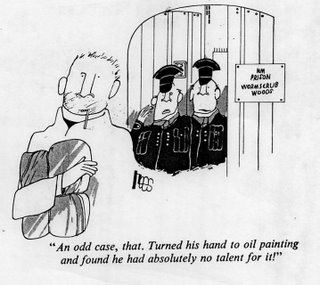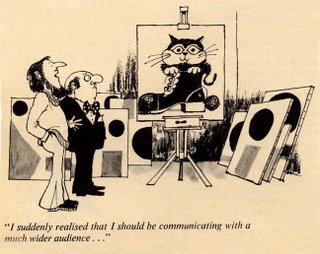
“The arts” or ‘Art’? What’s the difference?
‘Art’ as distinct to ‘the arts’ has had a specificity since the 19th Century. The term is associated with an idea that the artist’s creative life offers unique insight or potentially transforming revelation (see E.B. Browning and Daily Telegraph article in ‘Goering’ post, 25-10-06).
‘The arts’, and/or crafts, which includes painting, pottery, quilting, sculpture, carpentry, shoe making etc. on the other hand has a continuity of material practice through time, and still today produces valid and valued forms for aesthetic contemplation and enjoyment. We could say that ‘Art’ is a possible, but not essential attribute of ‘the arts’, and that ‘Art’ can exist independently of the material forms that are its customary vehicles i.e. ‘the arts’.

Why does this matter?
That depends on your point of view. For one thing most observers, certainly critics, contemporary theorists and others of their ilk, privilege contemporary ‘Art’ as worthy of greater regard, and, most importantly consider it significant for its contentiousness. That is, an art that contains ‘Art’, and as such is marked by modern (or post-modern) radicality, so making it dangerous to some.
What is this thing called ‘Art’?
This is not a question that is simply answered.
It could be described as a method, an attitude, a way of knowing and being, a cerebral and emotional ‘technology’, a process of coming to awareness, a critical engagement with the cognitive and perceptual frameworks that constitute assumed reality, a quest of psychological and philosophical inquiry. In short it is a form of inquiry and reflection about contemporary culture that communicates in a way that is critically conceptual and challenging. That is why it matters. That is why controlling regimes like it shut (shot) down.
‘Art’ occupies an important niche in the social environment and functions as a crucial element in democratic, civic and intellectual life. This is particularly so in the current circumstances of saturation government and corporate spin and the narrowing of the channels of media information. Through its language of sign, symbol and metaphor, it can, with some impunity, question the prevailing values that ruling elites manipulate to maintain power – patriotism, religion, ‘the market’, identity (racial, cultural) etc.
One of the effects of the semantic dissolve of culture, the arts and ‘Art’, (Goering post 25-10-06) is to “decommission” ‘Art’ while keeping “the arts” – to eliminate those culturally and politically uncomfortable, antisocial aspects of ‘Art’.
Perhaps it was ‘Art’ that got Goering’s goat; culture was not the target.

At the local level it is convenient for culture activists to base support for culture on instrumental grounds, not on ‘Art’s’ intrinsic value and its freedom to express, criticise, contest and interrogate. However the danger is that is easier to close cultural programmes (the arts and ‘Art’) on grounds of cost effectiveness, than to directly argue for the closure of critical debate about our politics and values, which is possible when there is no articulation of the differences.
Or you can foreclose: “Council is concerned that the Culture that develops in Gosford reflects our values and is never in conflict with them.” (Gosford City Cultural Plan – Action Plan.)
Or if you prefer Counter Culture: “In collaboration with Space Furniture, CounterArt is offering artists an opportunity to exhibit their work within its new gallery space in Sydney.” The cultural revolution meets retail values at a store near you in time for Christmas.
Another parting shot from the Browning: Robert this time.
“Tis you speak, that’s your error. Song’s our art:
Whereas you please to speak these naked thoughts
Instead of draping them in sights and sounds.
– True thoughts, good thoughts, thoughts fit to treasure up!
But why such long prolusion and display
Such turning and adjustment of the harp,
And taking it upon your breast, at length,
Only to speak dry words across its strings?
Stark-naked thought is in request enough:……”
From Transcendentalism, a poem in twelve books.
7 comments:
Your quote from the Gosford Cultural Plan was revealing. I think there might be some lessons to be learned from Wyong's Plan.
The plan mentions "development of Wyong township as a focus of cultural activity" and also quotes
Richard Florida, mentioned in a previous posts on this blog,“Cities need a people climate even more than they need a business climate. This means supporting creativity across the board - in all of its carious forms and dimensions"
Another quote from the plan:
"Municipalities around Australia are turning to the development of cultural precincts in the regeneration of town centres affected by the flight of retailing
and services to shopping malls."
Thank you for Back Page, I am finding the issues raised most interesting and important to Central Coast art.
Sometimes finding ideas about regenerating town centers is easier than getting them achieved. We have a lot of old attitudes and "old pals" blocking the view forward.
I think it has been very useful to distinguish between “Art” and “The Arts and Culture”. I was listening to a lecture yesterday that claimed that culture (with a capital C) is the enemy of art, and was reminded of the work Hans Haacke in the 1960’s, and how his Art was assimilated by the Culture industry and thus robbed of its bite.
And while we are in the 60’s, I have noticed that there is a renewed interest in text based conceptualism and its forebears, Da Da, Fluxus, the Situationists, etc. these days and this is mostly to be found on the web.
I wonder what there is about this time, so different in many ways, which is bringing out similar impulses in artists forty years later.
Thank you "Wyong resident", I don't usually pay much attention to council statements, but I checked the Wyong plan on their web-site and it does sound more artist friendly.
I don't know if you know anything about this, but the plan refers to the Mt. Penang Institute of Contemporary Art. Is that part of AISDA which has just moved up there? I asked some people who go there to walk their dogs, but they said they have not seen any signs.
The name sounds interesting anyway.
Hi Jenny,
Sorry I don't know any more, but I will ask around, maybe someone at the university would know.
Regards, Fiona. (Wyong resident)
Post a Comment